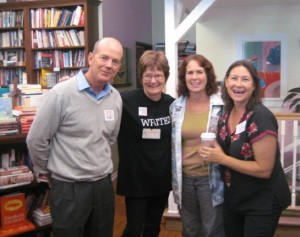Watching other authors in action is a great way to pick up presentation tips. And at the upcoming 58th Annual Breakfast with the Authors event in Santa Barbara on Saturday, I’ll not only experience a keynote talk by Susan Patron, but I’ll see & hear how 11 other authors deliver a 2-minute talk on the topic of “Becoming Lucky: Taking Chances.” (Yes! TWO minutes!) Now this is a speaking challenge indeed – and I’m still working on how I’m going to do this. (Hmmm. I wonder if the organizers will have a hook for long-winded authors?)

Authors Greg Trine, Alexis O'Neill, Mary Ann Fraser and Amy Koss did a showcase together at the Ventura County Reading Association's Book Love event.
Just last weekend, I was at two different events where I saw authors in action. One was at a bookstore signing with five other picture book authors. The other was at a reading association event where four of us, representing picture books through YA, did a showcase. I love observing the different ways my colleagues successfully connect with an audience. Some authors are noisy, others are quiet. Some authors connect though humor, others through interesting anecdotes, still others with compelling back stories about the making of their books. As different as the authors may be personality-wise, they share some significant commonalities: they make eye contact with their audience. They smile. They don’t talk at the audience – they seem to be having a conversation with them. They enjoy being where they are.
Keep your antennae up for author events at your local bookstores and libraries and attend whenever you can. When you tune into how an author connects with you, you’ll have a better idea of how you might connect with your audiences, too.

You are so right, Alexis. I always learn something by observing other authors. One thing I’ve noticed is the most successful ones let their personality show.
When I was first starting out, I asked a few authors whom I’d met through SCBWI if I could observe them “in action” at school visits. I learned a lot about how to structure my presentation and ways to engage the kids. If you offer to help schlep props or take photos, they can’t refuse!
Ruth – Thanks for bringing this up! Being a helper for authors is a perfect way to get the inside scoop on how an author not only delivers their assemblies, but also to get the Big Picture of how a whole day at a school can be structured. I’ve shadowed authors, and they’ve shadowed me. When they shadow me, I turn them into “evaluators.” I have them tell me if there were parts of the program that dragged, places where kids were squirming, and also places where the kids were particulary engaged. This has been so helpful to me! As a result of their comments, I’ve dropped draggy bits and squeezed more “engagment moments” into my program over the years. This especially helps when I’m trying out new material or introducting a new book.
Alexis, it is really hard for me to imagine any part of your school assembly program being “draggy,” as you are THE most entertaining and engaging visiting author I’ve ever seen. One of the many things I’ve learned from watching you over the years is the importance of keeping your programs flexible–how often do we expect to have a full hour to present and end up with half that amount of time, or even less? Knowing how many minutes each segment of your program takes can be a lifesaver when you are running out of time and have to drop something on the fly.
Kate – Just as I do with manuscripts, I’ve cut an revised my presentations as they evolve. So, yes, I’ve had draggy parts that I’ve eliminated so I can focus on the essentials of my main messages.